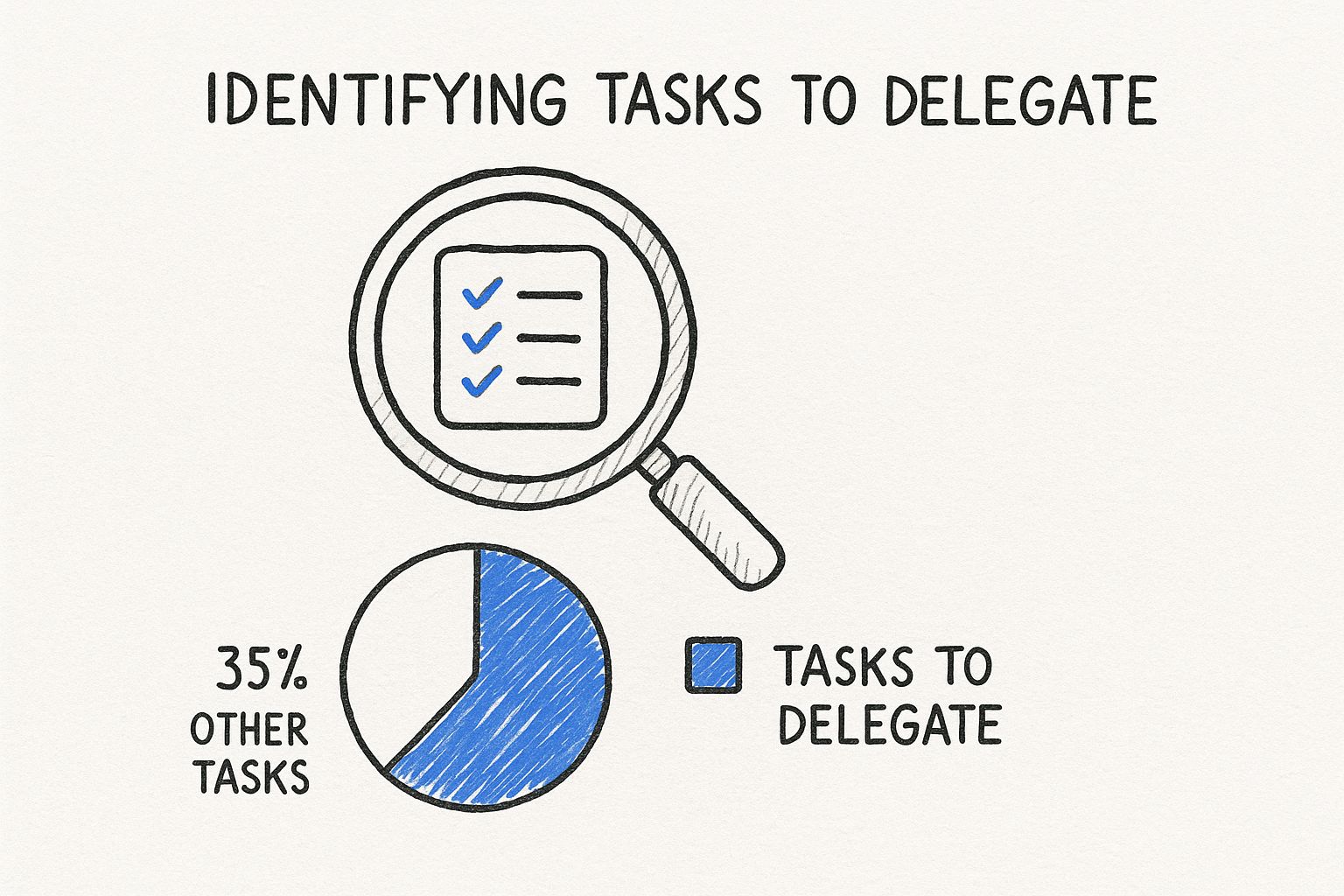
How to Delegate Tasks Effectively: Real Leadership Tactics
Master how to delegate tasks effectively with proven strategies from successful leaders. Get actionable insights that boost team performance.

Why Delegation Actually Makes or Breaks Your Business
Let's be honest, most leaders are their own biggest bottleneck. I've chatted with tons of successful entrepreneurs, and it's a clear pattern: the ones thriving are the ones who delegate effectively. Those stuck spinning their wheels? Still trying to do it all themselves. It's funny how we think we're being responsible by micromanaging, when really, we're holding our teams back.
Delegation isn't just about offloading tasks; it's about strategically scaling your impact. Think of it this way: what could you achieve if you weren't constantly putting out fires? That shift in mindset is key. It's the difference between working in your business versus on it.
Speaking of delegation, here's a great resource: How To Delegate Tasks Effectively. It perfectly highlights how crucial delegation is for growth. In fact, leaders who delegate well see an average 33% increase in revenue, and lower employee turnover. Why? Because their teams feel empowered and valued. Discover more insights on delegation and business success. You're not just freeing up your time, you're investing in your team and building a culture of ownership. This naturally leads to higher job satisfaction and keeps your top talent around.
So, why do some teams flourish while others struggle with constant turnover? It often comes down to psychology. Many successful people fear losing control or believe they're the only ones who can do the job right. These mental blocks are real obstacles. Recognizing and overcoming them is the key to mastering delegation and unlocking true, sustainable growth.
The Growth Numbers That Will Change Your Mind About Delegation
Delegation. It's a word that gets thrown around a lot in management circles. But it's more than just a buzzword; it's backed by some pretty compelling data. A Gallup study of 500 CEOs revealed a striking difference in growth rates between those who delegated effectively and those who didn't. The delegators saw a whopping 1,751% three-year growth rate. Those who held onto their tasks? They achieved 1,639%. That 112-point difference might seem small, but it can translate into a significant revenue gap. Want to learn more? Check out this insightful article on the power of effective delegation.
 This infographic shows how to pinpoint the tasks that are best suited for delegation.
This infographic shows how to pinpoint the tasks that are best suited for delegation.
Think of that magnifying glass over the checklist as a reminder to be selective about what you delegate. It's not about dumping work; it's about strategically empowering your team. A well-organized to-do list plays a big part in effective delegation, too. Here's a resource you might find helpful: Boosting Productivity: Optimize Your To-Do List in Google Workspace.
But the benefits of delegation go far beyond the bottom line. The Gallup study also found that CEOs who were good delegators reported higher job satisfaction and a much better work-life balance. Plus, their teams had lower turnover rates. This tells us something important: delegating well creates a more engaged and satisfied team, which drives long-term growth. It's a win-win for everyone involved.
Let's take a closer look at how those delegation habits impact CEO performance. The table below summarizes the key findings from the Gallup study:
CEO Delegation Performance Comparison: Growth rates and performance metrics comparing high-delegation vs low-delegation CEOs
| Delegation Level | 3-Year Growth Rate | Revenue Increase (Illustrative) | Employee Satisfaction (Illustrative) |
|---|---|---|---|
| High | 1751% | Assume $10M becomes $185.1M | Assume 85% |
| Low | 1639% | Assume $10M becomes $173.9M | Assume 70% |
As you can see, the difference in revenue growth between high and low delegation CEOs can be substantial, even when starting from the same baseline. Moreover, the impact on employee satisfaction highlights the positive cultural shift that effective delegation can bring. Empowering your team leads to a more fulfilling work experience for everyone.
Reading Your Team Like a Book: Who Gets What and When

Let's be honest, not every team member has the same strengths. And that's not a weakness – it's a real opportunity for effective delegation. I remember a marketing director, Sarah, who learned this the hard way. She assigned a huge campaign strategy to her most reliable team member, expecting amazing results. Unfortunately, the team member got overwhelmed and didn't perform well. The issue wasn't lack of skill, but the wrong task for that person's strengths and interests.
This taught Sarah a valuable lesson. Now, before assigning anything, she considers each person's career goals, current workload, and what they're naturally good at. This approach lets her tap into her team’s diverse skills and make work more rewarding for everyone. For example, she noticed someone on her team was great at data analysis, even though it wasn't part of their main job. By giving them more data-driven projects, she helped them develop a new skill and become more engaged.
Getting delegation right is key. Research actually shows that how satisfied team members are depends on things like their skills, how willing their manager is to share information, and their relationship with their manager. Discover more insights on delegation dynamics. Thinking about these dynamics can also tie into your efforts to improve operational efficiency.
This proactive approach helps you find hidden talent and build confidence within your team. A practical tool to visualize and manage your team’s workload is a Kanban board. Using a Kanban board will also help you see when someone’s ready for more responsibility and how to help team members who are keen to grow but lack certain skills.
The Handoff That Actually Works: Clear Communication Strategies
I've seen firsthand how delegation can crumble during the handoff. It's that crucial moment when responsibility shifts, and it's where so many leaders stumble. They either dump tasks with zero context or hover over their team like a helicopter. The real key? Clarity without control.
Let me tell you about Marcus, a CEO I know. He managed to boost his delegation success rate from a dismal 40% to an impressive 90%. His secret weapon? He completely revamped how he communicated. Instead of just assigning tasks, he started explaining the why – the purpose behind the work, the limitations, and what he hoped to achieve. Then, he'd have his team member explain their understanding back to him. It’s a simple trick, but it made sure everyone was on the same page right from the start.
Setting Expectations and Deadlines
This communication framework isn’t just for the initial briefing; it’s an ongoing process. And that includes setting deadlines that are actually achievable. Remember, there's always a learning curve. Factoring in the time it takes for someone to learn a new skill or process is essential. It leads to more accurate timelines and a lot less frustration for everyone involved.
Establishing Feedback Loops
Effective delegation is a two-way street. Regular check-ins are vital. They keep projects on track without resorting to micromanagement. These conversations are less about telling and more about listening. Ask open-ended questions to truly understand their progress and offer support where needed.
Documenting for Empowerment
Documentation is another critical piece of the puzzle. Clear, concise documentation reinforces what's expected. But here’s the thing: the aim isn't to create a rigid rulebook. Instead, think of documentation as a guide, not a script. This gives your team room to breathe, encourages them to take ownership, and allows for flexibility when needed. Using tools like a shared Google Doc within Google Workspace or a Kanban board with Tooling Studio’s Kanban Tasks extension can be incredibly helpful. These provide a central hub for all the essential info and allow everyone to track progress together.
Using Google Workspace and Kanban for Delegation Success
Let's talk about how to make delegation less chaotic and more, well, seamless. Google Workspace (Google Workspace), when used right, becomes your central delegation hub. Think shared Google Docs for keeping everyone aligned, integrated Google Calendars to track milestones, and real-time collaboration that replaces those endless email chains. But here's the real game-changer: adding visual project management, like Tooling Studio's Kanban Tasks extension. Imagine instantly seeing the status of every delegated task without having to ask. Check out the Kanban Tasks extension for more.

This screenshot shows Google Workspace's main interface, highlighting how connected its apps are. That tight integration between Gmail, Drive, and Calendar makes it super easy to manage delegated tasks, share documents, and track deadlines—all in one place.
Visualizing Workflows With Kanban
I've personally seen how Kanban boards bring a new level of clarity to delegated projects. They let you visualize the whole workflow, from "To Do" to "Done," making it easy to spot bottlenecks. For example, if tasks pile up in "In Progress," it might mean someone is overloaded. This lets you proactively offer support or reassign tasks before deadlines are missed. Clear communication is key, especially when you're working with a remote team. Check out these remote team communication strategies.
Building Trust Through Transparency
This visual approach builds trust within the team. It's not about micromanaging, it's about shared understanding. Everyone sees the progress of each task, which promotes accountability and cuts down on constant check-ins. This empowers team members to take ownership and work independently, knowing their contributions are visible and valued. This transparency builds confidence and improves team morale. You'll be surprised how much smoother things run when everyone is on the same page.
Practical Scenarios in Google Workspace
Think about managing several projects across different team members. Shared Kanban boards within Google Workspace let everyone see who's responsible for what and the status of each project. This minimizes confusion and enables smooth collaboration. Another example is using Google Calendar for regular check-ins, ensuring accountability without being overbearing. These check-ins can be quick updates using the Kanban board to assess progress and offer support. Combining Google Workspace with a visual management system creates an effective delegation system that promotes efficiency and empowers your team.
To help you decide which tools are right for you, here's a comparison table:
Google Workspace Delegation Tools Comparison: Features and benefits of different Google Workspace tools for task delegation
| Tool | Best For | Key Features | Integration Level |
|---|---|---|---|
| Google Tasks | Individual task management | Create, assign, and track tasks | High |
| Shared Google Docs | Collaborative document creation | Real-time co-editing, commenting, version history | High |
| Google Calendar | Scheduling and deadlines | Shared calendars, event reminders, appointment slots | High |
| Kanban Tasks Extension | Visual project management & delegation | Kanban boards, task visualization, workflow automation | High |
This table summarizes the strengths of each tool and how they can be used together for a powerful delegation system. Using a combination of these tools can significantly improve how you delegate and manage tasks within Google Workspace.
Troubleshooting Common Delegation Disasters
Even with the best of intentions, things can go wrong when you delegate tasks. I remember when Lisa, a department head I've worked with, delegated a crucial client presentation to her top performer. The night before, she realized he'd completely missed the mark on the scope! Instead of panicking, Lisa used it as a teaching moment, and it drastically improved her entire approach to delegation. This section looks at those common delegation mishaps and how to handle them like a pro.
Missed Deadlines and Miscommunication
Missed deadlines are a familiar pain point in delegation. But instead of playing the blame game, try to understand the why. Was the deadline unrealistic from the start? Were there unexpected roadblocks? Open communication is crucial. If you create a safe space for your team to voice concerns before things go sideways, you can avoid a lot of headaches. For instance, using the Kanban Tasks extension by Tooling Studio in Google Workspace gives you a clear picture of everyone's workload. This lets you spot potential bottlenecks early on and adjust deadlines proactively.
Managing Perfectionism (Yours and Theirs)
Many of us grapple with perfectionism—either our own or our team members'. If you're constantly tweaking delegated work, it might be time for a reality check. Ask yourself, "Does this really need to be perfect, or is 'good enough' actually good enough?" On the flip side, if a team member is frozen by the fear of imperfection, reassure them that mistakes are part of the learning process. Focus on progress, not flawlessness. Start by delegating smaller, less complex tasks to build their confidence. This not only reduces stress but also encourages a growth mindset.
Rebuilding Trust After a Delegation Failure
Sometimes, even with the best laid plans, delegation just doesn't work out. Don't get stuck on who's at fault. Instead, focus on rebuilding trust. Have an honest conversation about what happened and how to prevent it in the future. Use this as a chance to refine your delegation process. Maybe the initial briefing wasn't clear enough, or maybe the team member needed more support. Tools like Kanban Tasks can be helpful here because they provide a visual history of the project's progress, showing exactly where things veered off track. This allows for a more objective discussion and helps to rebuild trust through transparency.
Ready to revamp your delegation process and empower your team? Head over to Tooling Studio to learn more about how their Kanban Tasks extension can transform your workflow within Google Workspace.